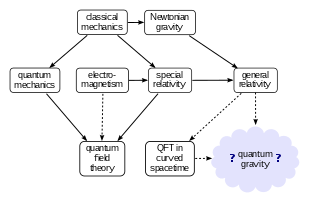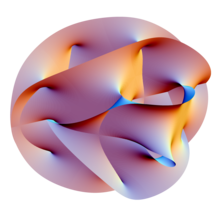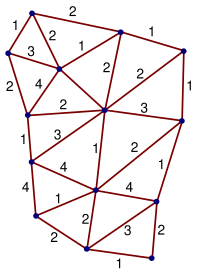Quantum gravity

Quantum gravity (QG) is a field of
Three of the four
The field of quantum gravity is actively developing, and theorists are exploring a variety of approaches to the problem of quantum gravity, the most popular being M-theory and loop quantum gravity.[8] All of these approaches aim to describe the quantum behavior of the gravitational field, which does not necessarily include unifying all fundamental interactions into a single mathematical framework. However, many approaches to quantum gravity, such as string theory, try to develop a framework that describes all fundamental forces. Such a theory is often referred to as a theory of everything. Some of the approaches, such as loop quantum gravity, make no such attempt; instead, they make an effort to quantize the gravitational field while it is kept separate from the other forces. Other lesser-known but no less important theories include Causal dynamical triangulation, Noncommutative geometry, and Twistor theory.[9]
One of the difficulties of formulating a quantum gravity theory is that direct observation of quantum gravitational effects is thought to only appear at length scales near the
Thought experiment approaches have been suggested as a testing tool for quantum gravity theories.[10][11] In the field of quantum gravity there are several open questions – e.g., it is not known how spin of elementary particles sources gravity, and thought experiments could provide a pathway to explore possible resolutions to these questions,[12] even in the absence of lab experiments or physical observations.
In the early 21st century, new experiment designs and technologies have arisen which suggest that indirect approaches to testing quantum gravity may be feasible over the next few decades.[13][14][15][16] This field of study is called phenomenological quantum gravity.
Overview
How can the theory of quantum mechanics be merged with the theory of

Much of the difficulty in meshing these theories at all energy scales comes from the different assumptions that these theories make on how the universe works. General relativity models gravity as curvature of spacetime: in the slogan of John Archibald Wheeler, "Spacetime tells matter how to move; matter tells spacetime how to curve."[17] On the other hand, quantum field theory is typically formulated in the flat spacetime used in special relativity. No theory has yet proven successful in describing the general situation where the dynamics of matter, modeled with quantum mechanics, affect the curvature of spacetime. If one attempts to treat gravity as simply another quantum field, the resulting theory is not renormalizable.[18] Even in the simpler case where the curvature of spacetime is fixed a priori, developing quantum field theory becomes more mathematically challenging, and many ideas physicists use in quantum field theory on flat spacetime are no longer applicable.[19]
It is widely hoped that a theory of quantum gravity would allow us to understand problems of very high energy and very small dimensions of space, such as the behavior of black holes, and the origin of the universe.[1]
Quantum mechanics and general relativity
Graviton
The observation that all
Nonrenormalizability of gravity
General relativity, like electromagnetism, is a classical field theory. One might expect that, as with electromagnetism, the gravitational force should also have a corresponding quantum field theory.
However, gravity is perturbatively
On the other hand, in quantizing gravity there are, in perturbation theory, infinitely many independent parameters (counterterm coefficients) needed to define the theory. For a given choice of those parameters, one could make sense of the theory, but since it is impossible to conduct infinite experiments to fix the values of every parameter, it has been argued that one does not, in perturbation theory, have a meaningful physical theory. At low energies, the logic of the renormalization group tells us that, despite the unknown choices of these infinitely many parameters, quantum gravity will reduce to the usual Einstein theory of general relativity. On the other hand, if we could probe very high energies where quantum effects take over, then every one of the infinitely many unknown parameters would begin to matter, and we could make no predictions at all.[30]
It is conceivable that, in the correct theory of quantum gravity, the infinitely many unknown parameters will reduce to a finite number that can then be measured. One possibility is that normal
Quantum gravity as an effective field theory
In an effective field theory, all but the first few of the infinite set of parameters in a nonrenormalizable theory are suppressed by huge energy scales and hence can be neglected when computing low-energy effects. Thus, at least in the low-energy regime, the model is a predictive quantum field theory.[32] Furthermore, many theorists argue that the Standard Model should be regarded as an effective field theory itself, with "nonrenormalizable" interactions suppressed by large energy scales and whose effects have consequently not been observed experimentally.[33] Works pioneered by Barvinsky and Vilkovisky [34][35][36][37] suggest as a starting point up to second order in curvature the following action, consisting of local and non-local terms:
where is an energy scale. The exact values of the coefficients are unknown, as they depend on the nature of the ultra-violet theory of quantum gravity. is an operator with the integral representation
By treating general relativity as an effective field theory, legitimate predictions can be made for quantum gravity, at least for low-energy phenomena. An example is the well-known calculation of the tiny first-order quantum-mechanical correction to the classical Newtonian gravitational potential between two masses.[32] Moreover, one can compute the quantum gravitational corrections to classical thermodynamic properties of black holes, most importantly the entropy. A rigorous derivation of the quantum gravitational corrections to the entropy of Schwarzschild black holes was provided by Calmet and Kuipers.[38] A generalisation for charged (Reissner–Nordström) black holes was subsequently carried out by Campos Delgado.[39]
Spacetime background dependence
A fundamental lesson of general relativity is that there is no fixed spacetime background, as found in
On the other hand, quantum mechanics has depended since its inception on a fixed background (non-dynamic) structure. In the case of quantum mechanics, it is time that is given and not dynamic, just as in Newtonian classical mechanics. In relativistic quantum field theory, just as in classical field theory,
String theory
Background independent theories
Topological quantum field theory provided an example of background-independent quantum theory, but with no local degrees of freedom, and only finitely many degrees of freedom globally. This is inadequate to describe gravity in 3+1 dimensions, which has local degrees of freedom according to general relativity. In 2+1 dimensions, however, gravity is a topological field theory, and it has been successfully quantized in several different ways, including spin networks.[citation needed]
Semi-classical quantum gravity
Quantum field theory on curved (non-Minkowskian) backgrounds, while not a full quantum theory of gravity, has shown many promising early results. In an analogous way to the development of quantum electrodynamics in the early part of the 20th century (when physicists considered quantum mechanics in classical electromagnetic fields), the consideration of quantum field theory on a curved background has led to predictions such as black hole radiation.
Phenomena such as the Unruh effect, in which particles exist in certain accelerating frames but not in stationary ones, do not pose any difficulty when considered on a curved background (the Unruh effect occurs even in flat Minkowskian backgrounds). The vacuum state is the state with the least energy (and may or may not contain particles).
Problem of time
A conceptual difficulty in combining quantum mechanics with general relativity arises from the contrasting role of time within these two frameworks. In quantum theories, time acts as an independent background through which states evolve, with the Hamiltonian operator acting as the generator of infinitesimal translations of quantum states through time.[41] In contrast, general relativity treats time as a dynamical variable which relates directly with matter and moreover requires the Hamiltonian constraint to vanish.[42] Because this variability of time has been observed macroscopically, it removes any possibility of employing a fixed notion of time, similar to the conception of time in quantum theory, at the macroscopic level.
Candidate theories
There are a number of proposed quantum gravity theories.[43] Currently, there is still no complete and consistent quantum theory of gravity, and the candidate models still need to overcome major formal and conceptual problems. They also face the common problem that, as yet, there is no way to put quantum gravity predictions to experimental tests, although there is hope for this to change as future data from cosmological observations and particle physics experiments become available.[44][45]
String theory

The central idea of string theory is to replace the classical concept of a
In what is called the
Loop quantum gravity

Loop quantum gravity seriously considers general relativity's insight that spacetime is a dynamical field and is therefore a quantum object. Its second idea is that the quantum discreteness that determines the particle-like behavior of other field theories (for instance, the photons of the electromagnetic field) also affects the structure of space.
The main result of loop quantum gravity is the derivation of a granular structure of space at the Planck length. This is derived from the following considerations: In the case of electromagnetism, the
The quantum state of spacetime is described in the theory by means of a mathematical structure called spin networks. Spin networks were initially introduced by Roger Penrose in abstract form, and later shown by Carlo Rovelli and Lee Smolin to derive naturally from a non-perturbative quantization of general relativity. Spin networks do not represent quantum states of a field in spacetime: they represent directly quantum states of spacetime.
The theory is based on the reformulation of general relativity known as Ashtekar variables, which represent geometric gravity using mathematical analogues of electric and magnetic fields.[52][53] In the quantum theory, space is represented by a network structure called a spin network, evolving over time in discrete steps.[54][55][56][57]
The dynamics of the theory is today constructed in several versions. One version starts with the
Other theories
There are a number of other approaches to quantum gravity. The theories differ depending on which features of general relativity and quantum theory are accepted unchanged, and which features are modified.[59][60] Examples include:
- Asymptotic safety in quantum gravity
- Euclidean quantum gravity
- Integral method[61][62]
- Causal dynamical triangulation[63]
- Causal fermion systems
- Causal Set Theory
- Covariant Feynman path integral approach
- Dilatonic quantum gravity
- Double copy theory
- Group field theory
- Wheeler–DeWitt equation
- Geometrodynamics
- Hořava–Lifshitz gravity
- MacDowell–Mansouri action
- Noncommutative geometry
- Path-integral based models of quantum cosmology[64]
- Regge calculus
- Shape Dynamics
- quantum graphity
- Supergravity
- Twistor theory[65]
- Canonical quantum gravity
Experimental tests
As was emphasized above, quantum gravitational effects are extremely weak and therefore difficult to test. For this reason, the possibility of experimentally testing quantum gravity had not received much attention prior to the late 1990s. However, in the past decade, physicists have realized that evidence for quantum gravitational effects can guide the development of the theory. Since theoretical development has been slow, the field of phenomenological quantum gravity, which studies the possibility of experimental tests, has obtained increased attention.[66]
The most widely pursued possibilities for quantum gravity phenomenology include gravitationally mediated entanglement,
The
On 23 February 2024, researchers reported studies that, for the first time, measured gravity at microscopic levels.[79][80]
See also
- De Sitter relativity
- Dilaton
- Doubly special relativity
- Gravitational decoherence
- Gravitomagnetism
- Hawking radiation
- List of quantum gravity researchers
- Orders of magnitude (length)
- Penrose interpretation
- Planck epoch
- Planck units
- Swampland (physics)
- Virtual black hole
- Weak Gravity Conjecture
Notes
- ^ Quantum effects in the early universe might have an observable effect on the structure of the present universe, for example, or gravity might play a role in the unification of the other forces. Cf. the text by Wald cited above.
- Planck length, in the examples
References
- ^ .
- ^ Overbye, Dennis (10 October 2022). "Black Holes May Hide a Mind-Bending Secret About Our Universe - Take gravity, add quantum mechanics, stir. What do you get? Just maybe, a holographic cosmos". The New York Times. Archived from the original on 16 November 2022. Retrieved 16 October 2022.
- ^ Starr, Michelle (16 November 2022). "Scientists Created a Black Hole in The Lab, And Then It Started to Glow". ScienceAlert. Archived from the original on 15 November 2022. Retrieved 16 November 2022.
- ISBN 978-0-19-958520-5.
- S2CID 14024934.
- ^ Nadis, Steve (2 December 2019). "Black Hole Singularities Are as Inescapable as Expected". quantamagazine.org. Quanta Magazine. Archived from the original on 14 April 2020. Retrieved 22 April 2020.
- ].
- OCLC 716437154.
- arXiv:gr-qc/0006061.
- S2CID 2684909.
- S2CID 5163793.
- S2CID 119342861.
- ^ Hossenfelder, Sabine (2 February 2017). "What Quantum Gravity Needs Is More Experiments". Nautilus. Archived from the original on 28 January 2018. Retrieved 21 September 2020.
- ISBN 9783319645360.
- S2CID 119073215.
- from the original on 2023-01-22. Retrieved 2022-12-11.
- ISBN 9780393079487.
- OCLC 659549695.
- ISBN 978-0-226-87027-4.
- .
- .
- .
- ^ Gupta, S. N. (1962). "Quantum Theory of Gravitation". Recent Developments in General Relativity. Pergamon Press. pp. 251–258.
- S2CID 14295121.
- .
- OCLC 873715753.
- from the original on 2020-08-06. Retrieved 2020-05-15.
- ISBN 978-0201627343.
- ISBN 978-3-540-85292-6.
- .
- ^ Distler, Jacques (2005-09-01). "Motivation". golem.ph.utexas.edu. Archived from the original on 2019-02-11. Retrieved 2018-02-24.
- ^ ISBN 978-981-02-2908-5.
- OCLC 255563633.
- .
- .
- .
- .
- S2CID 237091145.)
{{cite journal}}: CS1 maint: multiple names: authors list (link - S2CID 247824137.
- ISBN 978-0-465-07835-6. Pages 220–226 are annotated references and guide for further reading.
- ISBN 978-0-8053-8291-4.
- ISBN 978-0-7354-0131-0.
- ISBN 9789812777386)
- )
- S2CID 16762545.
- ISBN 978-0-521-63304-8.
- S2CID 15707877.
- ^ For the graviton as part of the string spectrum, e.g. Green, Schwarz & Witten 1987, sec. 2.3 and 5.3; for the extra dimensions, ibid sec. 4.2.
- ISBN 978-0-521-55002-4.
- Bibcode:1997hepcbconf..385T.
- S2CID 17432791.
- PMID 10033673.
- PMID 9958340.
- S2CID 119572847.
- from the original on 2020-01-22. Retrieved 2008-03-13.
- S2CID 119175535.
- S2CID 119151491.
- ISBN 978-0-521-71596-6.
- S2CID 119364176.
- S2CID 4803804.
- ^ Klimets, A. P. (2017). "Philosophy Documentation Center, Western University – Canada" (PDF). Philosophy Documentation Center, Western University – Canada. pp. 25–32. Archived (PDF) from the original on 2019-07-01. Retrieved 2020-04-24.
- ^ A.P. Klimets. (2023). Quantum Gravity. Current Research in Statistics & Mathematics, 2(1), 141-155.
- PMID 28191826.
- ISBN 978-0-521-37976-2.
- ^ See ch. 33 in Penrose 2004 and references therein.
- ISBN 978-1-61122-957-8. Archived from the originalon 2017-07-01. Retrieved 2012-04-01.
- from the original on 2023-01-22. Retrieved 2022-07-13.
- from the original on 2023-01-22. Retrieved 2022-07-13.
- from the original on 2023-01-22. Retrieved 2021-01-01.
- from the original on 2023-01-22. Retrieved 2021-01-01.
- from the original on 2023-01-22. Retrieved 2021-01-02.
- from the original on 2023-01-22. Retrieved 2021-01-02.
- S2CID 54727053.
- S2CID 243848123.
- ^ Abbasi, R. and others, IceCube Collaboration (June 2023). "Searching for Decoherence from Quantum Gravity at the IceCube South Pole Neutrino Observatory". arXiv:hep-ex/2308.00105.
- ^ "Integral challenges physics beyond Einstein". European Space Agency. 2011-06-30. Archived from the original on 2021-11-13. Retrieved 2021-11-06.
- from the original on 2023-01-22. Retrieved 2021-11-06.
- ^
Cowen, Ron (30 January 2015). "Gravitational waves discovery now officially dead". S2CID 124938210.
- ^ Lea, Robert (23 February 2024). "'Quantum gravity' could help unite quantum mechanics with general relativity at last - "By understanding quantum gravity, we could solve some of the mysteries of our universe — like how it began, what happens inside black holes, or uniting all forces into one big theory."". Space.com. Archived from the original on 24 February 2024. Retrieved 23 February 2024.
- from the original on 24 February 2024. Retrieved 24 February 2024.
Sources
- ISBN 9781107029118.
- ISBN 978-0-679-45443-4
Further reading
- Ahluwalia, D. V. (2002). "Interface of Gravitational and Quantum Realms". S2CID 119358167.
- )
- S2CID 118923209.
- Hamber, Herbert W. (2009). Hamber, Herbert W. (ed.). Quantum Gravitation. Springer Nature. ISBN 978-3-540-85292-6.
- Kiefer, Claus (2007). Quantum Gravity. Oxford University Press. ISBN 978-0-19-921252-1.
- Kiefer, Claus (2005). "Quantum Gravity: General Introduction and Recent Developments". S2CID 12984346.
- Lämmerzahl, Claus, ed. (2003). Quantum Gravity: From Theory to Experimental Search. ISBN 978-3-540-40810-9.
- ISBN 978-0-521-83733-0.
External links
- Weinstein, Steven; Rickles, Dean. "Quantum Gravity". In Zalta, Edward N. (ed.). Stanford Encyclopedia of Philosophy.
- "Planck Era" and "Planck Time" Archived 2018-11-28 at the Wayback Machine (up to 10−43 seconds after birth of Universe) (University of Oregon).
- "Quantum Gravity", BBC Radio 4 discussion with John Gribbin, Lee Smolin and Janna Levin (In Our Time, February 22, 2001)

![{\displaystyle {\begin{aligned}\Gamma &=\int d^{4}x\,{\sqrt {-g}}\,{\bigg (}{\frac {R}{16\pi G}}+c_{1}(\mu )R^{2}+c_{2}(\mu )R_{\mu \nu }R^{\mu \nu }+c_{3}(\mu )R_{\mu \nu \rho \sigma }R^{\mu \nu \rho \sigma }{\bigg )}\\&-\int d^{4}x{\sqrt {-g}}{\bigg [}\alpha R\ln \left({\frac {\Box }{\mu ^{2}}}\right)R+\beta R_{\mu \nu }\ln \left({\frac {\Box }{\mu ^{2}}}\right)R^{\mu \nu }+\gamma R_{\mu \nu \rho \sigma }\ln \left({\frac {\Box }{\mu ^{2}}}\right)R^{\mu \nu \rho \sigma }{\bigg ]},\end{aligned}}}](https://wikimedia.org/api/rest_v1/media/math/render/svg/a03889a2d52a55bd1786ad7c03bdec5db5ad8e3b)



